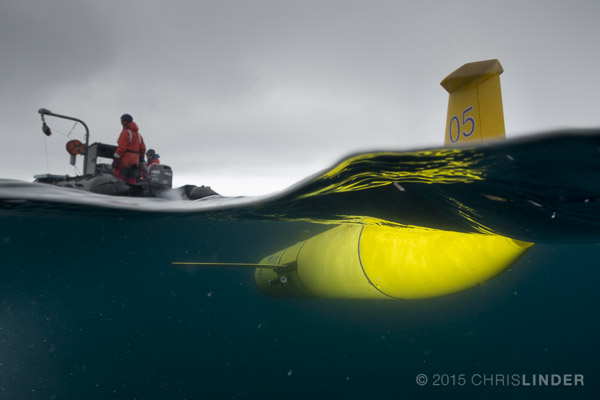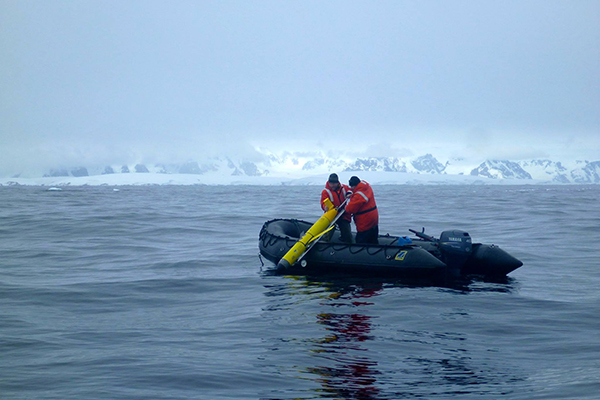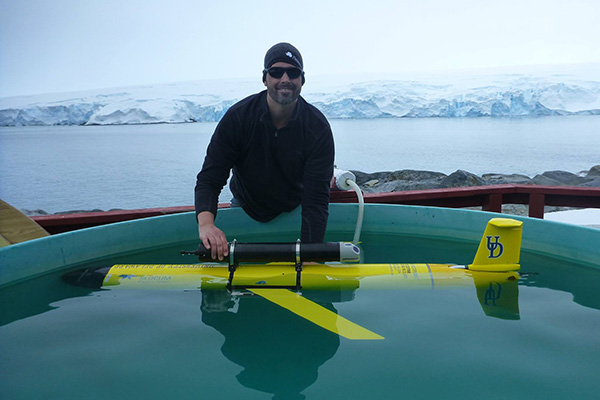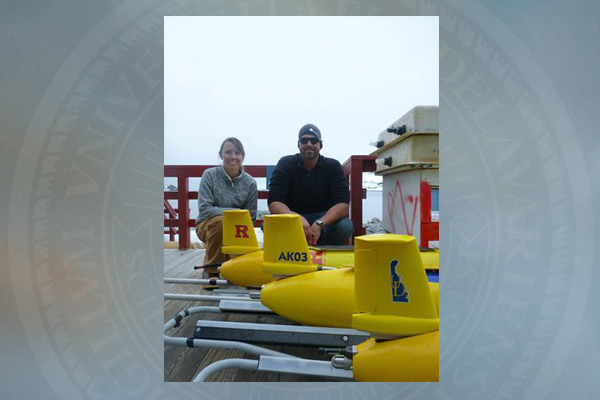Part 2: A tale of two poles
UD scientists deploy underwater robots over Palmer Deep in Antarctica
(Editor's note: This is the latest installment in a continuing series on research being conducted by University of Delaware scientists in the Arctic and Antarctica this month. For the Jan. 12 article, scroll down the page.)
12:09 p.m., Jan. 15, 2015--It’s been a visual smorgasbord for University of Delaware marine scientists on the way to the Antarctica. From sightings of black and white dolphins that look like pandas, known as Commerson’s dolphins, to a curious leopard seal, to an iceberg that resembled Queen Elsa’s castle in the Disney movie Frozen, the sights have been nothing short of breathtaking.
UD professor Matthew Oliver and Megan Cimino, a doctoral student in the College of Earth, Ocean, and Environment, and collaborating researchers recently deployed underwater robots -- torpedo-shaped gliders -- over Palmer Deep to learn more about what’s going on under the water’s surface. The robots can stay in the water for weeks at a time while sending back data every few hours, such as water salinity, currents and photosynthetic activity.
Research Stories
Chronic wounds
Prof. Heck's legacy
Oliver and Cimino are studying the local physical processes that affect how Adélie penguins forage for food, and the data from the glider about what’s happening below the surface is an important part of the work.
“We think convergence zones are concentrating the food web (phytoplankton and krill),” Oliver said in a Project CONVERGE post. “So these gliders are going to go fly through those zones and find out if that’s true.” The effect of convergence zones is one of the team’s scientific hypotheses, and the gliders provide a way for them to test their hypotheses.
The researchers are currently stationed out of Palmer Station, Antarctica, over 7,000 miles from Delaware. The current weather in Palmer Station is surprisingly balmy at 37 degrees, compared to 30-degree temperatures reported in Newark, Delaware this morning.
To view the Palmer Station webcam or the Torgerson Island Penguin Cam, click here.
Stay tuned for details on what’s happening in the Arctic in an upcoming post.
Jan. 12 posting: Opposite ends of the world
University of Delaware marine scientists from the College of Earth, Ocean, and Environment (CEOE) are on opposite ends of the world this month, studying Adélie penguins in Antarctica and sea jellies and other marine organisms in the Arctic.
CEOE scientists Matt Oliver, Megan Cimino and team are at Palmer Station on the West Antarctic Peninsula. They are investigating the local physical processes that affect how Adélie penguins forage for food, as part of Project CONVERGE, a collaborative research project between Rutgers University, UD, the Polar Oceans Research Group and the University of Alaska Fairbanks. Last fall, the team reported a connection between local weather and penguin chick weights in the journal Marine Ecology Progress Series.
Researchers Mark Moline and Jonathan Cohen are headed to the archipelago Svalbard, north of mainland Norway, to study how marine organisms — such as krill and sea jellies — survive when the sunlight disappears in the Arctic. Part of an international research team, the work builds on a 2014 excursion exploring how sea life copes with continuous winter darkness.
This is the first installment in an ongoing post through communications with UD research teams at the North and South poles. Follow their global journeys on social media -- and see photos -- using the hashtag #UDPolar.
Articles by Karen B. Roberts
Photos courtesy of Matthew Oliver and Megan Cimino, University of Delaware, and Chris Linder

















